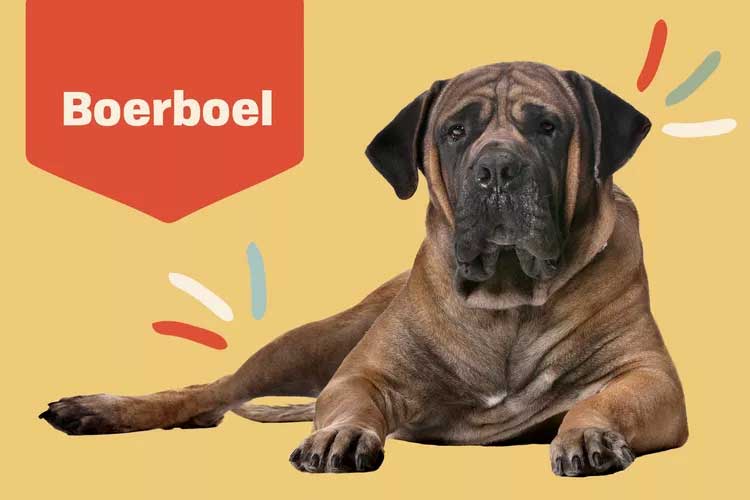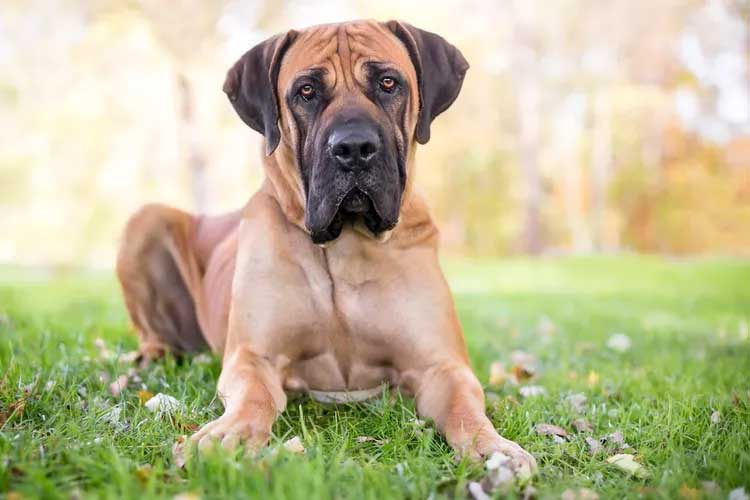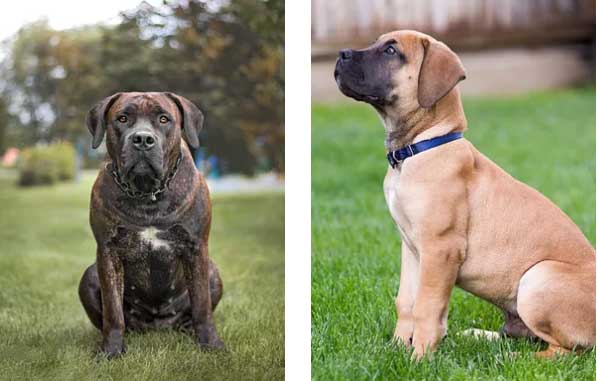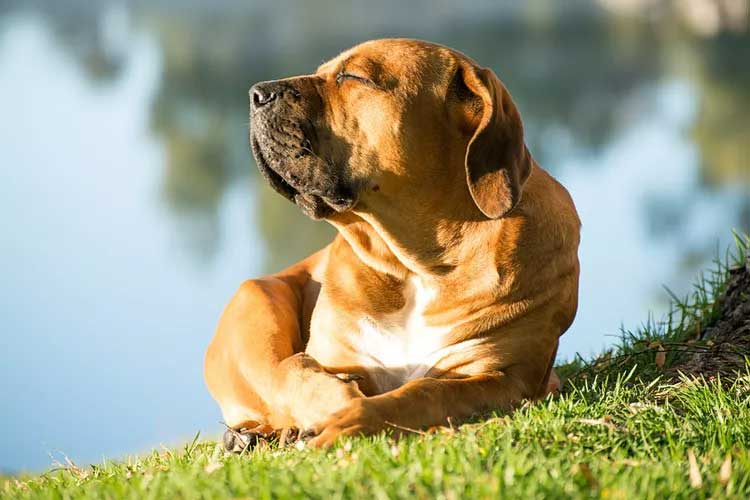
Boerboel Overview
| OFFICIAL NAME | Boerboel |
| COMMON NAME | South African Mastiff |
| PET HEIGHT | 22 to 27 inches |
| PET WEIGHT | 150 to 200 pounds |
| LIFESPAN | 9 to 11 years |
| GOOD WITH | children, families |
| TEMPERAMENT | friendly, outgoing |
| INTELLIGENCE | high |
| SHEDDING AMOUNT | normal |
| EXERCISE NEEDS | medium |
| ENERGY LEVEL | calm |
| VOCAL LEVEL | when necessary |
| DROOL AMOUNT | high |
| BREED GROUP | working |
| BREED SIZE | extra large (101 lbs. or more) |
| COAT LENGTH | short |
| COLORS | brown / chocolate / liver, cream, red |
| PATTERNS | bicolor, brindle, tricolor |
| OTHER TRAITS | good hiking companion, hot weather tolerant, loves water, strong loyalty tendencies |
When well-trained and socialized from an early age, boerboels can be gentle and loyal family dogs while still fulfilling the working role they were originally bred for: keeping a watchful eye over those they love. In the Afrikaans language, the name boerboel (pronounced "boo-r-bull") translates to "farmer's dog." And in South Africa, where the breed originated, that described these dogs' origin as farm guardians.
Weighing up to 200 pounds, this is a breed best suited to experienced dog owners. Boerboels are smart and highly trainable dogs who love attention from their humans, though with their size, having one in your family is like feeding another human adult. But these sweet dogs are well worth the grocery bills.
Appearance
The mighty boerboel is a broad, well–muscled dog who may weigh as much (or more) than his owner. As tall as 27 inches and weighing between 150–200 pounds, the boerboel makes for a powerful companion who is much more agile than other dogs of this size.
Boerboel colors include brindle, cream, brown, rust, and red, and their short and sleek coat can come in a variety of different markings. They shed a fair amount, but their coats are easily cared for. Their eyes are brown and horizontally set, helping give the boerboel his characteristic alert and intelligent expression.
Temperament
The boerboel temperament is one of a loving family dog. Though this is no pup for inexperienced owners, a well-adjusted boerboel can be a loving companion with the right guidance.Danny Jones, an AKC-registered boerboel breeder and owner of D & K Boerboels in St. Louis, Mo., says although he was attracted to the breed because of their impressive size, it's their temperament that he loves the most. "They are big babies at home, loyal to their family, and so good with children," Jones says. "They are really affectionate."
Though not every boerboel will be the perfect companion for kids, a well-socialized dog can fit in well with any and all family members, both two- and four-legged.

"In general, if they're treated with love and brought up nicely, larger dogs such as boerboels tend to be very calm and very docile," says Margaret Coffey, DVM, former hospital director of the School of Veterinary Medicine at Louisiana State University. "When you're breeding an animal of that size, you need to ensure that they have an even temperament, and that's what breeders are selecting for."
As with other giant dog breeds, you need to start boerboel training and socializing early, and be consistent. Jones says boerboels need boundaries and, with positive reinforcement, these smart dogs can be easy to train. Because of their intelligence and tendency to push boundaries, boerboels might not do well with first-time dog owners.
Living Needs
Boerboels aren't super active dogs, but they do need daily exercise like every other breed, whether that be long walks on a leash or plenty of play in a fenced-in backyard.Though the ideal situation for these dogs is likely a home with a big (fenced!) yard where they can play with their humans, this isn't essential, Coffey says.

"A lot of people will say, 'Well, I couldn't possibly have them in an apartment because they're just so big.' But often with a larger dog … so long as you meet their exercise needs, they tend to be a little lethargic at home," Coffey says. "Big dogs can make great apartment dogs and require way less attention than something like a Jack Russell."
Boerboels can get along well with other pets in the home, especially if they are raised together. As with all dogs, this comes down to socialization and training. Boerboels love being with their family, especially their special chosen person, and don't tolerate being left alone for long periods of time.
Historically, boerboels roamed huge farmlands in South Africa. So this is a breed that can easily keep up with you on long hikes, and Jones says that his dogs love to swim.
Care
Grooming your boerboel is easy. His dense, short coat will benefit from a weekly go-over with a soft–bristled brush or grooming mitt to help take out any loose hairs and to distribute his natural oils to give the coat a sleek, healthy look. You'll only need to give him the occasional bath, should he roll in something smelly or go for a muddy romp with you.The boerboel is an agile dog who needs daily exercise, but a few good, long walks or playtime in your backyard should keep him happy. The rest of the time he'll happily snooze the day away. If you have the inclination, your dog will love taking part in agility, weight–pulling, and stock competitions; as a smart working dog, they excel at those types of challenges.
One thing to know before bringing home a boerboel puppy: these dogs get big. Like, really big. And that means they need quite a bit of food to keep them full—costs that can quickly add up. Along with making sure you can dedicate time to train and socialize these pups, make sure your wallet can handle the bills as well.
Health
A boerboel's lifespan is 9–11 years, in line with other giant dogs. Although they are considered a generally healthy breed, they can suffer from the same issues that affect other giant pups such as hip dysplasia and cancer. "It doesn't seem fair that the giant breeds don't live very long, and can be more susceptible to cancer," Coffey says, adding that while all dogs can get cancer, bone cancers are much more prevalent in larger breeds.Another big-dog issue you should be aware of is bloat, a condition where the stomach twists and cuts off blood supply, which can kill a dog in hours. "It happens so quickly that most owners don't recognize what's going on. And by the time they get to the vet, the vet can't save them," Coffey says.
She notes that you can opt to have a simple preventative surgery in which the dog's stomach is stitched to the wall of their body cavity so that it cannot rotate; this can be carried out when you have your dog spayed or neutered. "We advise this for all large barrel-chested dogs now," Coffey says.
History
The boerboel has a long and extensive history, reaching all the way back to the Assyrian conquest of Egypt circa 677–663 BC, according to the American Boerboel Club. During this period, Mesopotamian mastiff dogs spread throughout Africa.
According to the breed club, this mastiff was brought to South Africa by Jan van Riebeeck, a Dutch navigator, in 1652. After breeding with other settlers' guard dogs, the boerboel began to take shape as a brave, muscular working dog. Primarily used for guarding, these pups protected everything from family farms to diamond mines.
Eventually, then these proud and mighty dogs became known outside of South Africa. In 2015, the American Kennel Club recognized the boerboel, which helped raise the breed's profile in North America.
Fun Facts
Boerboels are the only South African dog breed created to defend homesteads.American anthropologist Carl Semencic is credited with introducing boerboels to purebred enthusiasts worldwide in his 1998 book Gladiator Dogs.
A dog named Bilo was the first boerboel to participate in the Westminster Kennel Club Dog Show, in 2016.